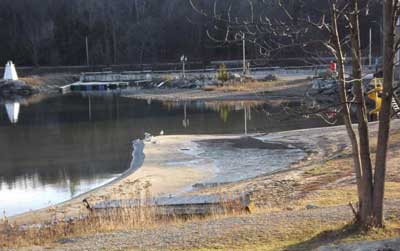MANITOULIN––The results are in, and it shows that for Lake Mindemoya there is a presence of rainbow smelt, an invasive species, a concern that had been raised by the M’Chigeeng First Nation prior to a broad scale monitoring (BSM) survey conducted by the Anishinabek/Ontario Fisheries Resource Centre (A/OFRC) from August 12-23.
“One of the main reasons we conducted this survey on the lake (which is within M’Chigeeng territory) was a concern raised by the M’Chigeeng First Nation about rainbow smelts being in the lake,” said Keith Nahwegahbow, fisheries technician with A/OFRC, on Monday. “The concern was raised that they are not supposed to be there and now this has been confirmed as we netted three rainbow smelts in our monitoring program.”
As reported previously, the A/OFRC, which works with the First Nations and M’Chigeeng, had undertaken the BSM as a result of the concern with rainbow smelt, an invasive species, and cormorants in the lake. The rainbow smelt replaces forage species so there is less food for native fish. “We are not specifically targeting a certain species of fish. We want to see what we have in terms of populations of all fish.”
Mr. Nahwaghbow had explained BSM is a provincial fishing monitoring protocol that is used to assess fish community abundance and characteristics for inland lakes. The protocol developed by the Ministry of Natural Resources (MNR) based on lake size and depth and what we will be doing is setting nets at difference depths and sites located. We will also take water chemistry tests and ideal temperature profiles. All of this information will then be entered into a database to compare with similar lakes of similar characteristics.
“We had a tough time of it in Mindemoya at first, the first couple of days were pretty windy and tough to set up our nets in different locations across the lake,” Mr. Nahwegahbow told the Recorder.
“But we were hammered with fish, there is definitely not a shortage of fish in the lake,” stated Mr. Nahwegahbow. “Our catch per unit (net) was 60, that’s extremely good because there is usually four or five,” he said, explaining, “We use a range of sized nets, small to large mesh nets 2.5 to 4.5 inches in size for the large nets. For the small nets we use less than a quarter of an inch size nets.”
The most abundant species of fish netted, “was the yellow perch,” said Mr. Nahwegahbow. “The next healthy population was walleye with 66 caught, the smallest being 700 grams and the largest being about 1.5 pounds. This caused a little concern because we thought we would catch a lot of smaller fish. There were no young fish caught, but we aren’t sure what this all means until we carry out the full analysis.”
Mr. Nahwegahbow told the Recorder the monitoring one pike caught, along with small mouth bass, rock bass, white sucker, whitefish, Cisco, and from the minnow species cannon shiners, black nose shiners, log perch, fathead minnow, spot tail shiner, and three rainbow smelts.
The MNR will be carrying out a carrying a fall walleye index netting (FWIN) survey, said Mr. Nahwegahbow. The FWIN survey will assess the overall status of walleye in Mindemoya Lake relative to provincial benchmarks that have been established for walleye.
The MNR study and the A/OFRC studies will then be put together. “We will do a full analysis of our data and share it with the MNR, as well as a fish population report to evaluate the overall status of the Mindemoya Lake fishery. He added, “through the small mesh nets we got hundreds of crayfish, which means there is food in the lake, and the reason the fish are thriving in the lake,” said Mr. Nahwegahbow.
All of this information will be used to assess fish community abundance and characteristics for inland lakes.
Mr. Nahwegahbow pointed out that upon completion of these projects, the BSM and MNR FWIN data will be combined to evaluate the overall status of the Mindemoya Lake fishery and to calibrate results for these provincially adopted fisheries protocols. “With these projects we will get a good picture of the lake, so the First Nation (and the MNR) can make property management decisions.”





